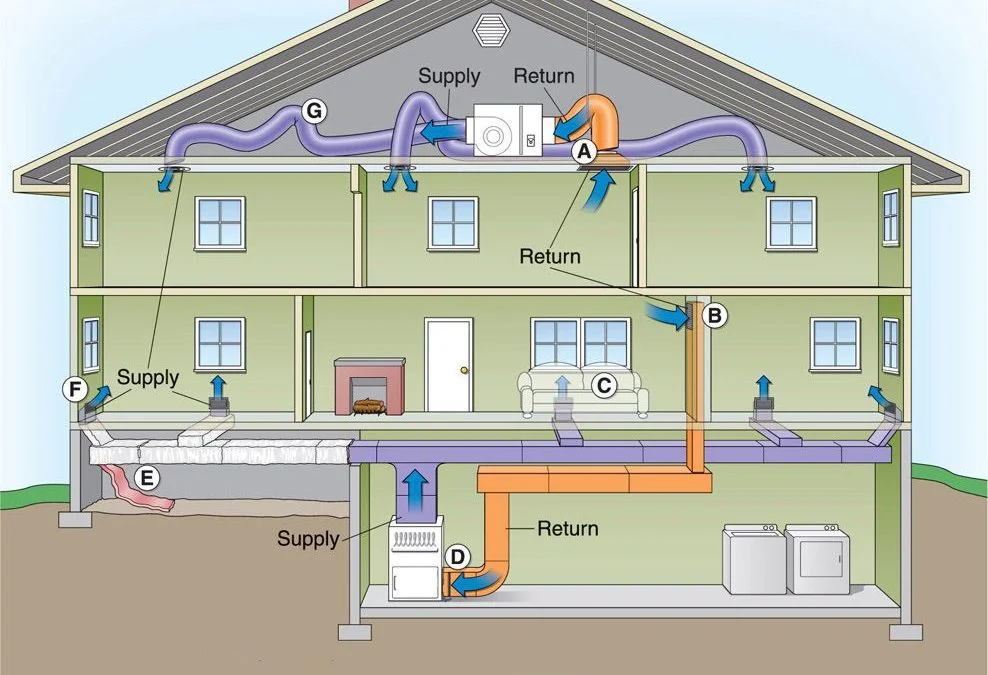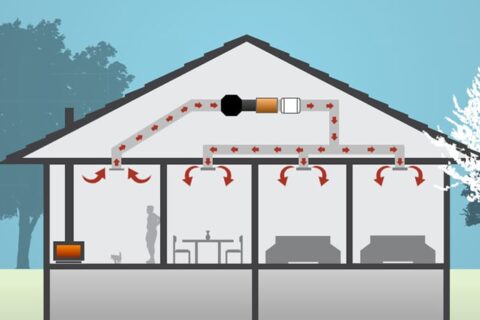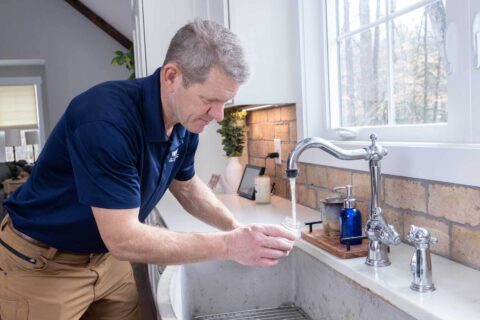High-Velocity HVAC Systems for Retrofitting Older Homes
Key Takeaways
-
High-velocity HVAC systems are space-saving alternatives to traditional HVAC systems, utilizing small, flexible ductwork to conveniently and efficiently deliver air. They are especially suited for retrofitting older homes that have no central hvac installed.
-
These high-velocity systems blow air at high speeds through small ducts. This increases overall temperature control, increases air distribution and indoor air quality while reducing dust accumulation.
-
Key components are energy-efficient air handlers, insulated tubing, and compact, circular vents. These characteristics allow for easy installation in spaces where conventional ductwork simply cannot go.
-
Besides energy efficiency, high-velocity systems have aesthetic benefits, with smaller vents that can often blend in more easily. They need little structural changes, aiding in maintaining the architectural merit of older homes.
-
Experience powerful, space-saving comfort that can bring temperatures up or down quickly. Plus, the additional dehumidification and super quiet operation helps create a comfortable and energy efficient indoor environment.
-
Retrofitting a high-velocity system involves professional assessment of the home’s structure, careful planning for ductwork, and selecting appropriately sized equipment for optimal performance.
High-velocity HVAC systems are an ideal option for historic homes. They allow for much easier installation of heating and cooling equipment where it’s challenging to do so with conventional systems. These systems work with small, flexible ducts that can slip easily into walls, ceilings, or floors, not requiring major renovations.
By providing PTAC-like conditioned air at high velocities but even more discreetly, they ensure temperature uniformity in the home while keeping its historic character intact. Their small footprint reduces structural interference, perfect for a retrofitted home with little room for oversized ducting.
That’s when the energy-efficient operation keeps utility bills low, delivering year-round comfort and savings. This way, homeowners can experience the best in modern climate control while maintaining the historic character of their home.
High-velocity HVAC systems provide an efficient and low-profile solution purpose-built to accommodate their distinctive requirements.
What Are High-Velocity HVAC Systems
High-velocity HVAC systems provide a space-saving and energy-efficient solution compared to conventional HVAC systems. These systems distribute air through smaller, more flexible ducts that can be as small as 2 inches in diameter. This design allows for much simpler installation in vintage homes where typical duct systems won’t work.
Because of this, high-velocity systems are able to integrate more fluidly into closed-in spaces. They don’t need huge, inflexible ductwork or extensive structural changes like traditional heating and cooling systems do. This makes them a wise option for retrofitting homes constructed before central air became ubiquitous in the 1970s.
High-velocity HVAC systems are about as old as HVAC systems themselves, having first come about in the 1940s. They were primarily designed to address heating and cooling issues in existing buildings. Their eco-friendly design proved to be a major advantage, especially as the world started warming up to green solutions.
Today, these systems are increasingly popular in residential markets, offering homeowners modern performance without sacrificing the character or layout of their homes. Their resurgence is being driven by their promise to reduce energy use. Furthermore, they save up to 25% in air duct leakage, making them an efficient air conditioning solution.
They play an important role in improving indoor air quality by reducing dust accumulation and reducing humidity levels by up to 29%. High-velocity HVAC systems come with attractive advantages for homeowners. They do a great job updating those old homes while making them energy efficient and comfortable at the same time.
How They Work
High-velocity systems differ from traditional HVAC systems, as they rely on the high-speed travel of air through narrow, flexible ducts. These unobtrusive ducts, combined with high-pressure airflow, facilitate the rapid and even distribution of conditioned air throughout an efficient home. The high velocity of this air conditioning solution aids in maintaining consistent room temperatures, ensuring superior comfort across the entire house.
Another significant advantage of these systems is their enhanced air mixing capabilities, which greatly improve air flow in a given space. This process effectively reduces hot and cold areas, providing even temperature control throughout the area. Additionally, the design minimizes dust accumulation, ensuring better air quality and reducing costly maintenance needs.
Many older home experts recognize that older homes often suffer from poor air quality due to age or outdated design. The high-velocity system addresses this issue, leveling the playing field for air conditioning needs. Furthermore, the system excels in lowering humidity levels, making it ideal for those living in humid climates.
The high-pressure air blown through outlets efficiently removes excess moisture, contributing to a more comfortable and healthier indoor environment. This is particularly beneficial in regions where conventional air conditioning systems may struggle to maintain optimal humidity levels.
Key Components
A high-velocity HVAC unit includes many super specialized elements, each playing a role in making the system as strong, efficient, and smart as possible. The air handler is the heart of any high-velocity HVAC system, controlling airflow and temperature all in one unit.
These compact yet powerful handlers are designed to deliver high-pressure air through the mini ducts. The systems directly heat or cool spaces, using insulated tubing to prevent energy loss. This insulation ensures that the air stays at the desired temperature while it moves through the ducts.
This insulation takes the system’s energy efficiency to the next level. This creates a very cost-effective option over time. Circular vents, their other signature design, enable flush installation for a more subtle look.
These vents can be designed to flush mount directly into walls or ceilings, protecting the aesthetic integrity of historic homes. These smaller vents are less obtrusive than large, bulky ones seen in more traditional systems. These units are more easily located in great locations to maximize the benefits of airflow.
Differences From Traditional Systems
One of the most striking contrasts between high-velocity HVAC systems and traditional HVAC systems is the ductwork. High-velocity ducts are up to 50% smaller than conventional duct systems, allowing them to fit into vintage homes where larger ducts won’t work. This smaller size helps reduce thermal loss, as the decreased surface area preserves the efficiency of airflow.
Perhaps the biggest difference that high-velocity systems have to normal systems is the speed of the airflow. These systems are typically designed to move air at high speeds. As such, they heat and cool more quickly, responding instantaneously to changing temperature needs.
This increased efficiency usually leads to lower monthly energy bills, offsetting the initial increased cost. Aesthetic considerations are another aesthetic consideration. Many older homes are filled with beautiful architectural details that the homeowner would like to maintain.
Smaller, less conspicuous vents found in high-velocity systems are less likely to impact aesthetics. This attribute makes them an ideal candidate for retrofitting into unique indoor comfort properties.
Benefits of High-Velocity HVAC Systems
1. Efficient Cooling and Heating
High-velocity HVAC systems are uniquely skilled at effectively cooling or heating indoor spaces, thanks to innovative airflow mechanics. These high-velocity systems are able to cool rooms quickly and evenly, using half the air needed for standard units. On a humid sweltering hot day, the high-velocity system will help cool the space down to comfort quickly.
This impressive efficiency can greatly minimize the operating time for air handlers. This allows them to save energy and reduce their utility bills at the same time. This more even air distribution contributes to better temperature control across the house, preventing the appearance of cold or hot spots that can break comfort.
In winter, these systems push warm air throughout a space, making them ideal for climate control year-round.
2. Space-Saving Design
That compact design of high-velocity systems works beautifully in older homes where space is usually at a premium. High-velocity HVAC systems use smaller ducts, around 2 inches in diameter, that take up much less space. They adapt easily to fit into thin walls, ceilings, and even narrow crawlspaces.
The vents are unobtrusive and can even match existing decor, providing a clean aesthetic. This design minimizes the need for extensive renovations, saving square footage and historic character. For example, homebuilders can prevent the need to demolish walls or give up closet space to make room for large ductwork.
3. Minimal Structural Modifications
Choosing high-velocity systems for renovation of old homes is a snap. High-velocity flexible ductwork lets you work around obstacles such as beams and other structures without issue. This reduces installation disruptions and the need to make extensive renovations.
Unlike conventional systems, which need bigger ducts and more invasive renovations, high-velocity systems maintain the home’s historic character. For legacy homes that have historical significance, this characteristic is more advantageous, helping to keep the property’s character preserved.
4. Enhanced Indoor Air Quality
High-velocity systems are actively working to keep IAQ high by continuously filtering allergens, dust, and other particles from the air being circulated. This increased airflow reduces the potential for stagnation creating much healthier indoor environments. They can dehumidify 30% more moisture than conventional systems.
This in turn helps control humidity levels and prevents the risk of mold outbreaks. In more humid climates, these systems help to keep the air drier. This allows you to raise the thermostat up and still feel comfortable.
Fewer respiratory irritants from cleaner air means a healthier home environment for all occupants.
5. Quiet Operation
Innovative developments have recently made high-velocity systems significantly quieter than traditional HVAC units. The proprietary, soundproofing technology keeps the operation whisper quiet, even in sound sensitive environments such as bedrooms or home offices.
This all helps to deliver a quiet environment, without annoying buzzing or rattling. For instance, a family might benefit from getting a restful night’s sleep or a student being able to study without the noise.
Combined with the comfort that comes from quiet operation, these systems are a smart option for any home.
Retrofitting High-Velocity Systems in Older Homes
Assess Existing Structure
Evaluating an older home’s compatibility with a high-velocity HVAC system involves careful examination of several factors, especially when considering the installation of a modern duct system. Older homes often have outdated or insufficient insulation, which can affect the efficiency of central air conditioning systems. Assessing this ensures the system operates efficiently, minimizing energy loss. Missing or thin insulation may need upgrading for optimal performance.
High-velocity systems need the smaller ducts to be at all efficient. To determine whether you need replacements or retrofits, it’s important to first know the state of your existing ductwork. High-velocity systems use flexible tubing, making it easier to install in tight spaces like wall cavities or ceilings without major alterations.
Unique features like vaulted ceilings or historic moldings require tailored solutions to integrate the air conditioning solution without disrupting the home’s character.
Plan Ductwork Installation
Effective ductwork installation involves a plan that integrates the system within the home’s existing structure. Flexible tubing is useful to go around obstructions like beams or mantelpieces. Key considerations for duct planning include positioning vents to evenly distribute airflow while remaining discreet.
Straight runs allow for better airflow which puts less strain on the system. Tight seals prevent leaks that could lower efficiency by up to 20%. Airflow patterns are equally important. In older, multi-story homes, ducts are an important aspect of comfort.
They should ensure consistent heating and cooling across all floors without creating drafts or hot spots.
Choose the Right Unit
Choosing the right unit begins with determining the home’s heating and cooling requirements. A high-velocity system uses BTU ratings to size its capacity to the square footage of the home. In other words, a 2,000-square-foot house usually needs a cooling system rated at 36,000 BTUs.
Units with higher SEER ratings save energy, which lowers utility costs. Working with an HVAC professional will better ensure that performance needs and efficiency requirements are balanced, including compatibility with existing heating sources such as gas boilers.
Consider Energy Efficiency
These energy-efficient systems provide long-term savings by reducing utility bills. Higher SEER rated systems, 18 and above, use less energy in peak cooling months. In the long run, that 40% efficiency advantage over conventional systems pays back the upfront investment.
Additionally, many high-efficiency units qualify for rebates or tax incentives, further reducing upfront costs and encouraging eco-friendly practices.
Address Potential Challenges
Older homes sometimes have unique challenges such as no space to run ducts or structural oddities that need to be overcome with innovation. Expert technicians are able to adjust and adapt installations to avoid marring the architectural detail, allowing operations to proceed without damaging the look.
Regular communication with contractors will help nip any problems in the bud, getting them fixed or addressed without dragging the project down in the process. Space limitations, for instance, might necessitate locating air handlers in basements or attics.
Maintenance Tips for High-Velocity Systems
Maintaining a high-velocity HVAC system in an older home requires a proactive approach to ensure the air system operates efficiently and delivers unique indoor comfort consistently.
-
Clean or replace air filters regularly for unobstructed airflow.
-
Check ducts for leaks or damage to maintain efficiency.
-
Schedule yearly tune-ups to keep components functioning well.
-
Watch for irregularities in performance to address issues early.
Clean Air Filters Regularly
In addition, clean air filters are essential to maintaining the system performance. When air filters are dirty, they limit airflow, making the system work harder, resulting in less efficiency and higher energy bills. Change filters every 1-3 months depending on use.
Things such as the presence of pet dander or pollen can impact performance, so be proactive to keep it running smoothly! Aside from allowing air to flow more freely, high-quality filters can help improve indoor air quality, too, creating a healthier, more comfortable home.
Inspect and Maintain Ducts
A duct inspection will find any leaks or holes that let conditioned energy escape. Sealing these leaks not only helps systems run efficiently but keeps the cool air from escaping outside. Clean ducts help promote good indoor air quality by reducing allergens and dust.
In the case of excessive dirt accumulation, the system’s original functionality can be regained through the use of a professional cleaning service.
Schedule Professional Tune-Ups
Regular annual tune-ups by trained HVAC technicians catch small problems before they spiral into expensive repairs. A complete inspection will make sure every part, from your blower to your compressor, is operating at peak performance.
Regular professional checks increase the lifespan of your system, allowing you to stay cool and comfortable when summer hits its peak heat months.
Monitor System Performance
Stay vigilant with your system and pay attention to warning signs, such as unusual sounds or fluctuating temperatures. Increased energy use at a sudden rate can indicate a lack of efficiency.
Tackling performance problems immediately avoids stress on the system and costly fixes, keeping comfort coming without interruption.
Optimize Thermostat Settings
-
Maintain consistent temperatures to avoid overworking the system.
-
Use programmable thermostats for better energy management.
-
Adjust settings seasonally for optimal comfort.
-
Check thermostat calibration to ensure accuracy.
Cost Considerations for High-Velocity Systems
Initial Installation Costs
It takes a significant upfront investment to install high-velocity HVAC systems. The net bottom line cost, equipment and install combined, comes in for the average home in the $10-20,000 range. The unit itself usually costs $1,800 to $2,900—labor and material costs increase to $350-$500.
Installation typically only takes 1 to 3 days, depending on the system’s complexity and the size of the home. Largely due to their age, installation is easier in homes that are older. They don’t have access to existing ductwork, meaning the system’s small, flexible ducts can be installed without extensive renovations.
Labor costs can vary considerably, so it’s best to obtain several estimates from reputable local HVAC professionals. Financing options can further allow you to budget for these initial costs so that the transition is more affordable while still providing quality.

Long-Term Energy Savings
In the long run, high-velocity systems can provide significant energy savings. Their space-saving design means shorter run times, reducing electricity consumption by up to 25%. That efficiency means lower utility bills, going some way toward covering that initial investment.
For homeowners, the long-term ROI makes these systems an attractive option. Regular maintenance, such as changing filters every one to three months, further helps the system operate efficiently.
Factors Affecting Pricing
A number of factors play a part in high-velocity system cost. Larger homes or more complicated layouts can drive up costs with added labor and materials. Advanced technology or higher energy-efficiency ratings may increase upfront costs, but they deliver superior performance.
Budgeting for long-term maintenance is critical to ensuring the system stays cost-effective over time.
Common Misconceptions About High-Velocity Systems
Noise Levels and Operation
Misconception #2 – High-velocity systems are noisy. This misconception comes from perceptions based on decades-old technology or systems installed incorrectly. Today’s better high-velocity systems, including those from Unico and SpacePak, feature improved technology that makes them extremely quiet.
With correctly formed ductwork and exact air handling, the noises are discreet and just noticeable. Sound attenuators, which are designed to dampen airflow noise, provide an additional level of quiet—perfect for bedrooms or other noise-sensitive areas. Homeowners are happier in part because they have a quieter home, but because they benefit from the comfort of more even airflow.
Properly installing high-velocity systems is crucial to keeping operational noise to a minimum. When installed properly, the system’s small, flexible ducts deliver the conditioned air in a quiet, effective manner without the loud noise that can be jarring.
Today’s high-velocity systems provide high-end performance and luxury comfort. Compared to traditional systems, they are the perfect solution for maintaining a quiet indoor living space.
Compatibility With Older Homes
A major consideration is if these systems are suitable for existing homes. High-velocity systems, by design, are an antidote to this challenge. Their space-efficient, compact ductwork can weave through walls and ceilings with little to no structural damage.
For instance, because Unico’s ducts can be a quarter of the size of standard ones, they allow historical homes to keep their character intact. Even landmark buildings have been tastefully retrofitted without extensive gut renovations. Their small-footprint air handlers easily slip into tight spaces such as attics or closets, eliminating the requirement for large basements.
This flexibility allows them to be the perfect fit for homes with complex architectural details. Homeowners shouldn’t have to lose their home’s character or architectural integrity.
Rather, they can upgrade to efficient, modern cooling and heating solutions that integrate into their current design with little disruption.
Energy Efficiency Myths
High-velocity systems are less energy-efficient than traditional systems. This is a myth. In practice, these systems do far better than traditional HVACs on almost all measures. Conventional systems waste up to a quarter of conditioned air from duct leaks!
High-velocity systems such as Unico systems lose very little, making sure that all cooled or heated air is delivered to where it’s needed the most. That can make a big difference in energy bills over time.
Don’t forget that proper sizing and installation is key to maximizing efficiency. When properly sized to your home’s needs, these systems provide even temperatures with no energy-hogging waste.
Additionally, high-velocity systems make zoning easy to implement, letting you manage temperatures separately in various parts of your home. This maximizes the efficiency of your system by ensuring you’re only using energy where it’s needed, saving you money on wasted energy.
Ongoing maintenance has a big part to play too. With routine maintenance, these systems remain exceptionally efficient for decades.
In reality, they usually extend beyond 26 years, well beyond the 10 to 15 years of conventional systems. This longevity serves to increase their overall cost-effectiveness, making them a long-term investment for energy-conscious homeowners.
Conclusion
High-velocity HVAC systems offer a clever remedy for vintage homes. They’re well-suited for tight spaces, help circulate air throughout a home, and bring the comfort of modern HVAC technology without extensive home renovations. These systems are ideal for maintaining the character of vintage homes, all while providing modern-day heating and cooling comfort.
By taking care of the system it will make things easier now, and extend its life further down the road. Basic upkeep, such as regularly replacing or cleaning filters and ensuring vents are unobstructed, goes a long way. While the upfront cost may seem daunting, the long-term savings in addition to the long-term comfort created with these systems certainly justifies the initial investment.
If you’re looking to improve the year-round comfort in your vintage abode, then considering high-velocity HVAC systems is a logical step. Request a knowledgeable contractor take you through the available choices and help you determine which is best suited for your home. With high-velocity systems, comfort doesn’t mean compromise.
Frequently Asked Questions
What is a high-velocity HVAC system?
A high-velocity HVAC system is an efficient home solution that distributes cooled air through small, flexible ducts. This innovative air system is engineered to deliver maximum comfort in minimal space, making it ideal for retrofitting vintage homes lacking extensive ductwork.
Why are high-velocity HVAC systems good for older homes?
These systems are ideally suited for vintage homes, as they require little to no major renovation. The unobtrusive ducts can be easily installed through existing walls and ceilings, protecting the home’s original structure and aesthetics.
How much space do high-velocity ducts take up?
High-velocity ducts, measuring as little as 2 inches across, are an excellent air conditioning solution for vintage homes, requiring much less space than conventional duct systems, making them ideal for houses with limited ductwork.
Are high-velocity HVAC systems energy-efficient?
Yes, high-velocity HVAC systems are energy-efficient solutions for vintage homes. These systems heat or cool homes quickly, maintaining consistent room temperatures while reducing energy consumption and lowering utility bills over time.
How much does it cost to install a high-velocity HVAC system?
The price tag for installing a central air conditioning system can be significant, typically ranging from $10,000 to $15,000, depending on the size of the vintage home and the individual needs of the home. While the upfront cost is higher, the improved system efficiency and space-saving advantages make it well worth the investment.
Do high-velocity HVAC systems require special maintenance?
No, it’s not that they require any special maintenance. Routine maintenance like regularly replacing filters and arranging for annual inspections are all it takes to keep the system operating efficiently.
Are high-velocity HVAC systems noisy?
No, they’re made to run quietly. Today, high-velocity systems come with sound-dampening technology to ensure whisper-quiet operation, making the systems pleasant to have in a home.


